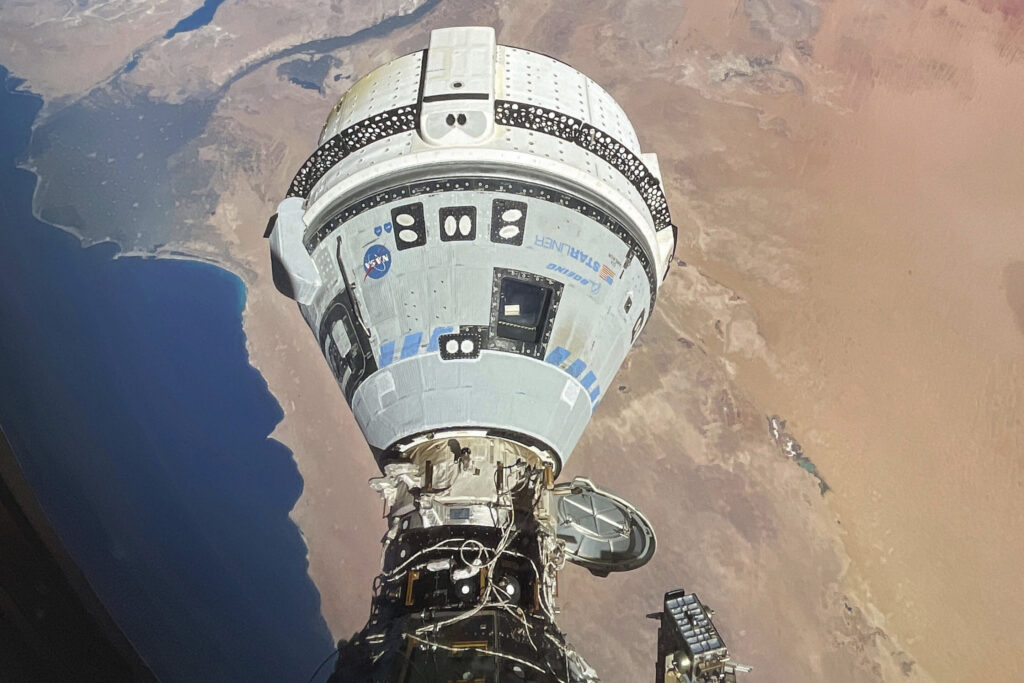The Starliner Reaction Control System (RCS) thruster has been undergoing intensive ground testing at the White Sands Test Facility in New Mexico for the past month by Boeing and NASA engineers. Through these initiatives, the problems that occurred during the Starliner’s trip in early June are to be found and fixed. As per Boeing’s most recent report, the teams have effectively imitated the thrust reduction that Starliner encountered. They are currently going through all of the data that has been gathered closely. Though progress has been made, it is still unclear when astronauts Butch Wilmore and Suni Williams will return. The only information provided by NASA and Boeing is that the astronauts will return “in the coming weeks.”
The latest flying conditions of Starliner were replicated in the ground tests. Almost 1,000 pulses were performed by the engineers to simulate the conditions of the Crew Flight Test (CFT), putting the control system thruster through one of the most stressful launch-to-docking firing sequences possible. In addition to undocking and deorbit burn scenarios, which are crucial stages of Starliner’s return trip to Earth, these exhaustive tests also covered other scenarios. Ensuring that similar problems do not arise during the astronauts’ real return trip was one of the main objectives of these tests, which also aimed to collect extensive data to determine the reason for the thrust decline.
The teams accumulated terabytes of data from these tests, a testament to the thoroughness and intensity of their efforts. Following the initial series of tests, the engineers conducted more aggressive testing to see if they could more accurately simulate the higher thermal conditions that the thrusters experienced in-flight. Dan Niedermaier, Boeing’s engineer responsible for the thruster testing, highlighted the importance of these additional tests in understanding the thermal stresses and their impact on the thruster’s performance.
The engineers are now in the process of performing detailed “engine tear downs and inspections,” as stated by Steve Stich, NASA’s Commercial Crew Program manager, during a recent update. These inspections are critical for identifying any internal issues that might have contributed to the thrust degradation. The teardown process involves disassembling the thrusters and examining each component for signs of wear, damage, or other anomalies that could explain the performance issues.
NASA intends to carry out an Agency Flight Test Readiness Review after these analyses are finished. In order to ascertain whether the Starliner spacecraft is in good shape and prepared to return the astronauts safely, a thorough evaluation will be conducted. To make sure that all potential problems have been taken care of, the review will entail assessing the data gathered from the ground tests, the outcomes of the engine checks, and any other pertinent information.
NASA and Boeing have committed to providing more information in an upcoming conference. This conference will be crucial for updating the public and stakeholders on the status of the Starliner spacecraft, the findings from the tests and inspections, and the planned timeline for the astronauts’ return. It will also provide an opportunity for NASA and Boeing to demonstrate their commitment to transparency and safety in their operations.
The rigorous testing and analysis process undertaken by Boeing and NASA underscores the complexity and challenges of space missions. Ensuring the reliability and safety of the Starliner spacecraft is paramount, given the stakes involved in human spaceflight. The issues experienced during the early June flight highlighted the need for thorough testing and meticulous analysis to understand and mitigate any risks.
The scenario illustrates not just the technological difficulties but also the cooperative character of space exploration. In order to overcome the problems with the Starliner spaceship, Boeing and NASA have been collaborating closely and combining their resources and experience. The cooperation of governmental and private organizations in furthering space exploration and guaranteeing the security and accomplishment of human missions is demonstrated by this partnership.
The Starliner spacecraft is a key component of NASA’s Commercial Crew Program, which aims to develop safe, reliable, and cost-effective transportation to and from the International Space Station (ISS). The program represents a significant shift towards commercial partnerships in space exploration, leveraging the innovation and efficiency of private companies like Boeing.
An important milestone for the Starliner program will be the impending return mission of astronauts Butch Wilmore and Suni Williams. In addition to proving the dependability and safety of the Starliner spacecraft, the successful return of the astronauts will validate the intensive testing and efforts undertaken by Boeing and NASA. Furthermore, it will enhance the position of commercial partners in human spaceflight and open the door for more missions.
Further lessons for future space flights can be learned from the extensive testing and analysis procedures used on the Starliner RCS thruster. If space missions are to be successful and safe, it is imperative that the underlying causes of technological problems be identified and addressed through thorough testing and analysis. Future spacecraft and system testing, as well as their design, will be influenced by the information and understanding obtained from the Starliner tests, in addition to helping the ongoing mission.
The difficulties and complications of space exploration are illustrated by the massive testing and analysis efforts undertaken by NASA and Boeing for the Starliner RCS thruster. The procedure emphasizes the value of careful testing, careful analysis, and teamwork in resolving technical problems and guaranteeing the security and accomplishment of human spaceflight. The results of the tests and inspections will be critical in guaranteeing that the Starliner spacecraft is prepared for a safe and successful voyage as NASA and Boeing get ready for astronauts Butch Wilmore and Suni Williams’ return flight. The next meeting will showcase the continued dedication to safety and quality in space exploration while offering more updates and insights into the plans and developments for the Starliner program.
If you like the article please follow on THE UBJ.
